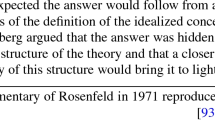Abstract
The question of what should be meant by a measurement is tackled from a mathematical perspective whose physical interpretation is that a measurement is a fundamental process via which a finite amount of classical information is produced. This translates into an algebraic and topological definition of measurement space that caters for the distinction between quantum and classical measurements and allows a notion of observer to be derived.
Similar content being viewed by others
References
Abramsky, S., Vickers, S.: Quantales, observational logic and process semantics. Math. Struct. Comput. Sci. 3(2), 161–227 (1993)
Araki, H.: Mathematical theory of quantum fields, International Series of Monographs on Physics, 101, Translated from the 1993 Japanese original by Ursula Carow-Watamura; Reprint of the 1999 edition, Oxford University Press, Oxford, xii+236 (2009)
Armstrong, A., Clark, L.O., an Huef, Jones, M., Lin, J.-F.: Filtering germs: groupoids associated to inverse semigroups. Expositiones Mathematicae (2021). https://doi.org/10.1016/j.exmath.2021.07.001
Bassi, A., Ghirardi, G.: Dynamical reduction models. Phys. Rep. 379(5–6), 257–426 (2003). https://doi.org/10.1016/S0370-1573(03)00103-0
Batelaan, H., Gay, T.J., Schwendiman, J.J.: Stern-Gerlach effect for electron beams. Phys. Rev. Lett. 79(23), 4517–4521 (1997)
Bell, J.: Against ‘measurement’. Phys. World 3(8), 33–40 (1990)
Bohm, D.: A suggested interpretation of the quantum theory in terms of “hidden’’ variables. I and II. Phys. Rev. 2(85), 166–193 (1952)
Bombelli, L., Lee, J., Meyer, D., Sorkin, R.D.: Space-time as a causal set. Phys. Rev. Lett. 59(5), 521–524 (1987). https://doi.org/10.1103/PhysRevLett.59.521
Ciaglia, F.M., Ibort, A., Marmo, G.: A gentle introduction to Schwinger’s formulation of quantum mechanics: the groupoid picture. Modern Phys. Lett. A 33, 1850122 (2018). https://doi.org/10.1142/S0217732318501225
Ciaglia, F.M., Ibort, A., Marmo, G.: Schwinger’s picture of quantum mechanics. I, II, III, Int. J. Geom. Methods Mod. Phys. 16, 1950119 31, 1950136 32, 1950165 37 (2019)
Christensen, J.D., Crane, L.: Causal sites as quantum geometry. J. Math. Phys. 46(12), 122502 (2005). https://doi.org/10.1063/1.2138043
de Silva, N., Barbosa, R.S.: Contextuality and noncommutative geometry in quantum mechanics. Commun. Math. Phys. 365(2), 375–429 (2019). https://doi.org/10.1007/s00220-018-3222-9
DeWitt, B.S.: Quantum mechanics and reality. Phys. Today 23(9), 30–35 (1970). https://doi.org/10.1063/1.3022331
Döring, A., Isham, C.J.: A topos foundation for theories of physics. I, II, III, IV, J. Math. Phys. 49 (2008), 053515 1–25, 053516 1–26, 053517 1–31, 053518 1–29
Durham, I.T.: An order-theoretic quantification of contextuality. Information 5, 508–525 (2014). https://doi.org/10.3390/info5030508
Everett, H., III.: “Relative state’’ formulation of quantum mechanics. Rev. Mod. Phys. 29, 454–462 (1957). https://doi.org/10.1103/revmodphys.29.454
Ghirardi, G.C., Pearle, P., Rimini, A.: Markov processes in Hilbert space and continuous spontaneous localization of systems of identical particles. Phys. Rev. A (3) 42(1), 78–89 (1990). https://doi.org/10.1103/PhysRevA.42.78
Gierz, G., Hofmann, K.H., Keimel, K., Lawson, J.D., Mislove, M., Scott, D.S.: Continuous lattices and domains, Encyclopedia of Mathematics and Its Applications, 93, Cambridge University Press, Cambridge (2003), xxxvi+591
Heunen, C., Landsman, N.P., Spitters, B.: A topos for algebraic quantum theory. Commun. Math. Phys. 291(1), 63–110 (2009). https://doi.org/10.1007/s00220-009-0865-6
Johnstone, P.T.: The point of pointless topology. Bull. Am. Math. Soc. (N.S.) 8(1), 41–53 (1983)
Joos, E., Zeh, H.D., Kiefer, C., Giulini, D., Kupsch, J., Stamatescu, I.-O.: Decoherence and the appearance of a classical world in quantum theory, 2, Springer, Berlin (2003), xii+496, https://doi.org/10.1007/978-3-662-05328-7
Landsman, K.: Foundations of quantum theory, Fundamental Theories of Physics, 188, From classical concepts to operator algebras, Springer, Cham (2017), xv+881, https://doi.org/10.1007/978-3-319-51777-3
Mulvey, C.J.: Second topology conference (Taormina, 1984). Rend. Circ. Mat. Palermo 2 12, 99–104 (1986)
Mulvey, C.J.: Quantales, Invited talk at the Summer Conference on Locales and Topological Groups (Curaçao, 1989)
Mulvey, C.J., Pelletier, J.W.: On the quantisation of points. J. Pure Appl. Algebra 159(2–3), 231–295 (2001)
Penrose, R.: On the gravitization of quantum mechanics 1: quantum state reduction. Found. Phys. 44(5), 557–575 (2014). https://doi.org/10.1007/s10701-013-9770-0
Resende, P.: Quantales, finite observations and strong bisimulation. Theoret. Comput. Sci. 254(1–2), 95–149 (2001)
Resende, P.: Étale groupoids and their quantales. Adv. Math. 208(1), 147–209 (2007)
Resende, P.: Groupoid sheaves as quantale sheaves. J. Pure Appl. Algebra 216(1), 41–70 (2012). https://doi.org/10.1016/j.jpaa.2011.05.002
Resende, P.: Quantales and Fell bundles. Adv. Math. 325, 312–374 (2018). https://doi.org/10.1016/j.aim.2017.12.001
Resende, P.: The many groupoids of a stably Gelfand quantale. J. Algebra 498, 197–210 (2018). https://doi.org/10.1016/j.jalgebra.2017.11.042
Resende, P.: On the geometry of physical measurements: topological and algebraic aspects. arXiv:2005.00933v3 (2021)
Resende, P., Santos, J.P.: Linear structures on locales. Theory Appl. Categ. 31, (2016), Paper No. 20, 502–541. http://www.tac.mta.ca/tac/volumes/31/20/31-20.pdf
Rosenthal, K.I.: Quantales and Their Applications, Pitman Research Notes in Mathematics Series, 234, Longman Scientific & Technical, Harlow, x+165 (1990)
Rovelli, C.: Relational quantum mechanics. Int. J. Theoret. Phys. 35(8), 1637–1678 (1996). https://doi.org/10.1007/BF02302261
Schwinger, J.: The algebra of microscopic measurement. Proc. Natl. Acad. Sci. USA 45, 1542–1553 (1959). https://doi.org/10.1073/pnas.45.10.1542
Smolin, L.: The case for background independence. In: The Structural Foundations of Quantum Gravity, pp. 196–239. Oxford University Press, Oxford (2006). https://doi.org/10.1093/acprof:oso/9780199269693.003.0007
Stoy, J.E.: Denotational semantics: the Scott-Strachey approach to programming language theory, MIT Press Series in Computer Science, 1, Reprint of the 1977 original; With a foreword by Dana S. Scott, MIT Press, Cambridge, Mass.-London, xxx+414 (1981)
Vickers, S.: Topology via logic, Cambridge Tracts in Theoretical Computer Science, 5, Cambridge University Press, Cambridge, xvi+200 (1989)
Vickers, S.: Locales and toposes as spaces. In: Aiello, M., Pratt-Hartmann, I., Van Benthem, J. (eds.) Handbook of Spatial Logics, pp. 429–496. Springer, Dordrecht (2007)
Wheeler, J.A.: Assessment of Everett’s “relative state’’ formulation of quantum theory. Rev. Mod. Phys. 29, 463–465 (1957). https://doi.org/10.1103/revmodphys.29.463
Wheeler, J.A.: Information, physics, quantum: the search for links, Foundations of quantum mechanics in the light of new technology (Tokyo, 1989). Phys. Soc. Jpn. 354–368 (1990)
Zeh, H.-D.: On the interpretation of measurement in quantum theory. Found. Phys. 1(1), 69–76 (1970)
Zeh, H.-D.: Towards a quantum theory of observation. Found. Phys. 3(1), 109–116 (1973)
Zurek, W.H.: Decoherence, einselection, and the quantum origins of the classical. Rev. Modern Phys. 75(3), 715–775 (2003). https://doi.org/10.1103/RevModPhys.75.715
Acknowledgements
Work funded by FCT/Portugal through project UIDB/04459/2020.
Author information
Authors and Affiliations
Corresponding author
Additional information
Publisher's Note
Springer Nature remains neutral with regard to jurisdictional claims in published maps and institutional affiliations.
Rights and permissions
About this article
Cite this article
Resende, P. An Abstract Theory of Physical Measurements. Found Phys 51, 108 (2021). https://doi.org/10.1007/s10701-021-00513-1
Received:
Accepted:
Published:
DOI: https://doi.org/10.1007/s10701-021-00513-1




